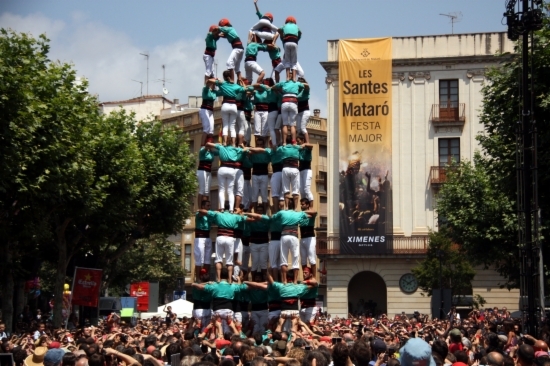Catalan Castells are safer than ever with only 2.5% of the towers collapsing in 2013
The medical director of the Coordinadora de Colles Castelleres de Catalunya (the coordinating committee of the human towers of Catalonia – CCCC), Daniel Castillo, has announced that the tradition is just as dangerous as practicing any other sport. Two weeks ago, a casteller (Castell participant) was seriously injured in Barcelona during the construction of a Castell. However, in an interview with the CNA, Castillo highlighted how that historical tradition is, in fact, becoming safer with only 2.5% of the 6,500 Castells of 2013 collapsing. “During the 1990s about 7% of Castells collapsed”, he noted. Castells is a tradition unique to Catalonia and in 2010 was declared a UNESCO element of Intangible Cultural Heritage of Humanity.

Barcelona (ACN).- In an interview with the CNA, the medical director of the Coordinadora de Colles Castelleres de Catalunya (the coordinating committee of the human towers of Catalonia – CCCC), Daniel Castillo, highlighted how there has been a recent downward trend in accidents in the creation of the Castells. Two weeks ago, a casteller (Castell participant) was seriously injured in Barcelona during the creation of one of the human towers. In spite of this, Castillo noted how in recent years the amount of accidents involving Castells (literally meaning castles) has reduced significantly and that it is “equally dangerous as practicing any other sport”. This year’s rate of accidents is, so far, “less than last year, in which 3% of the total 9,300 Castells involved accidents”, according to Castillo.
“During the 1990s the rate was far higher with an average accident rate of 7%”, he continued. It does appear the historical tradition is becoming safer of the 6,500 Castells constructed this year, only 2.5% collapsed. The tradition of creating the human castles began around 200 years ago in the Tarragona region of Catalonia. The towers are created by amateur groups and are formed by the castellers standing on the shoulders of each other. They normally take place during local festivals in Catalan towns and cities and tend to involve between 6 and 10 levels of people. In 2010 the tradition was declared a UNESCO element of Intangible Cultural Heritage of Humanity.
Improved safety measures
Two months ago, the CCCC began a study in order to create a neck protector to be used by the castellers. “We are looking for of material that will allow complete mobility during the creation of the Castells, but will become rigid in case a fall occurs”, revealed Castillo. Although no deadline has been set for the completion of the neck protector, it is hoped that a prototype will be ready by May 2014. The medical director noted that “we are at a very early stage, and we do not know when it will be available”. He stressed that the CCCC provides training for the castellers and they are working towards making sure that each group has a team that specialises in keeping the activity as safe as possible. It is now compulsory that the children form the top levels of the Castells wear safety helmets.
A total of 77 Castell groups
The practice of creating Castells is more popular than ever with a total of 77 forming part of the CCCC. The towers are normally created during festivals and cultural events that take place within Catalan towns and cities and the groups compete with each other to create the highest and most elaborate tower. In 2010 the tradition was declared a UNESCO element of Intangible Cultural Heritage of Humanity. It was awarded the honour because of the values of collective self-improvement and solidarity that it promotes, as well its ability to integrate people of all ages and walks of life into the same project.